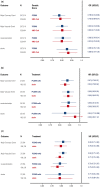Reduction of low density lipoprotein-cholesterol and cardiovascular events with proprotein convertase subtilisin-kexin type 9 (PCSK9) inhibitors and statins: an analysis of FOURIER, SPIRE, and the Cholesterol Treatment Trialists Collaboration
- PMID: 29020411
- PMCID: PMC6047439
- DOI: 10.1093/eurheartj/ehx450
Reduction of low density lipoprotein-cholesterol and cardiovascular events with proprotein convertase subtilisin-kexin type 9 (PCSK9) inhibitors and statins: an analysis of FOURIER, SPIRE, and the Cholesterol Treatment Trialists Collaboration
Figures


Similar articles
-
[Inhibitors of PCSK9].Rev Med Suisse. 2017 Apr 12;13(558):821-825. Rev Med Suisse. 2017. PMID: 28727332 French.
-
Adherence to proprotein convertase subtilisin/kexin 9 inhibitors in high cardiovascular risk patients: an Italian single-center experience.J Cardiovasc Med (Hagerstown). 2018 Feb;19(2):75-77. doi: 10.2459/JCM.0000000000000611. J Cardiovasc Med (Hagerstown). 2018. PMID: 29251697 No abstract available.
-
Proprotein Convertase Subtilisin Kexin 9 Inhibitors.Cardiol Clin. 2018 May;36(2):241-256. doi: 10.1016/j.ccl.2017.12.006. Cardiol Clin. 2018. PMID: 29609754 Review.
-
PCSK9 Inhibitors: Treating the Right Patients in Daily Practice.Curr Cardiol Rep. 2017 Aug;19(8):66. doi: 10.1007/s11886-017-0882-6. Curr Cardiol Rep. 2017. PMID: 28643240 Review.
-
Effects of Proprotein Convertase Subtilisin/Kexin Type 9 (PCSK9) Inhibition with Bococizumab on Lipoprotein Particles in Hypercholesterolemic Subjects.Clin Ther. 2017 Nov;39(11):2243-2259.e5. doi: 10.1016/j.clinthera.2017.09.009. Epub 2017 Oct 14. Clin Ther. 2017. PMID: 29037448
Cited by
-
Cardiologist and Diabetologist crosstalk in the era of cardiovascular outcome trials of novel glucose-lowering drugs.Int J Cardiol Heart Vasc. 2018 Oct 24;21:80-86. doi: 10.1016/j.ijcha.2018.10.001. eCollection 2018 Dec. Int J Cardiol Heart Vasc. 2018. PMID: 30402533 Free PMC article. Review.
-
Is There a Need to Revise Goals in the Management of Dyslipidemias?Curr Cardiol Rep. 2019 Apr 30;21(6):51. doi: 10.1007/s11886-019-1128-6. Curr Cardiol Rep. 2019. PMID: 31041621 Review.
-
Low-density lipoprotein cholesterol lowering therapy for the secondary prevention of atherosclerotic cardiovascular disease.Glob Cardiol Sci Pract. 2020 Dec 31;2020(3):e202039. doi: 10.21542/gcsp.2020.39. Glob Cardiol Sci Pract. 2020. PMID: 33598499 Free PMC article. Review.
-
Inclisiran: How Widely and When Should We Use It?Curr Atheroscler Rep. 2022 Oct;24(10):803-811. doi: 10.1007/s11883-022-01056-0. Epub 2022 Jul 25. Curr Atheroscler Rep. 2022. PMID: 35877035 Free PMC article. Review.
-
Invasive coronary imaging of inflammation to further characterize high-risk lesions: what options do we have?Front Cardiovasc Med. 2024 Feb 1;11:1352025. doi: 10.3389/fcvm.2024.1352025. eCollection 2024. Front Cardiovasc Med. 2024. PMID: 38370159 Free PMC article. Review.
References
-
- Sabatine MS, Giugliano RP, Wiviott SD, Raal FJ, Blom DJ, Robinson J, Ballantyne CM, Somaratne R, Legg J, Wasserman SM, Scott R, Koren MJ, Stein EA.. Open-Label Study of Long-term Evaluation Against LDL Cholesterol (OSLER) Investigators. Efficacy and safety of Evolocumab in reducing lipids and cardiovascular events. N Engl J Med 2015;372:1500–1509. - PubMed
-
- Robinson JG, Farnier M, Krempf M, Bergeron J, Luc G, Averna M, Stroes ES, Langslet G, Raal FJ, El Shahawy M, Koren MJ, Lepor NE, Lorenzato C, Pordy R, Chaudhari U, Kastelein JJ, ODYSSEY LONG TERM Investigators. Efficacy and safety of alirocumab in reducing lipids and cardiovascular events. N Engl J Med 2015;372:1489–1499. - PubMed
-
- Sabatine MS, Giugliano RP, Keech AC, Honarpour N, Wiviott SD, Murphy SA, Kuder JF, Wang H, Liu T, Wasserman SM, Sever PS, Pedersen TR, FOURIER Steering Committee and Investigators. Evolocumab and clinical outcomes in patients with cardiovascular disease. N Engl J Med 2017;376:1713–1722. - PubMed
-
- Ridker PM, Revkin J, Amarenco P, Brunell R, Curto M, Civeira F, Flather M, Glynn R, Gregoire J, Jukema JW, Karpov Y, Kastelein JJ, Koenig W, Lorenzatti Manga P, Masiukiewicz U, Miller M, Mosterd A, Murin J, Nicolau JC, Nissen S, Ponikowski P, Santos RD, Schwartz PF, Soran H, White H, Wright RS, Vrablik M, Yunis C, Shear CL, Tardif JC, SPIRE Cardiovascular Outcome Investigators. Cardiovascular efficacy and safety of bococizumab in high-risk patients. N Engl J Med 2017;376:1527–1539. - PubMed
-
- Baigent C, Keech A, Kearney PM, Blackwell L, Buck G, Pollicino C, Kirby A, Sourjina T, Peto R, Collins R, Simes R, Cholesterol Treatment Trialists' (CTT) Collaborators. Efficacy and safety of cholesterol-lowering treatment: prospective meta-analysis of data from 90,056 participants in 14 randomised trials of statins. Lancet 2005;366:1267–1278. - PubMed
Publication types
MeSH terms
Substances
LinkOut - more resources
Full Text Sources
Other Literature Sources
Medical
Miscellaneous

